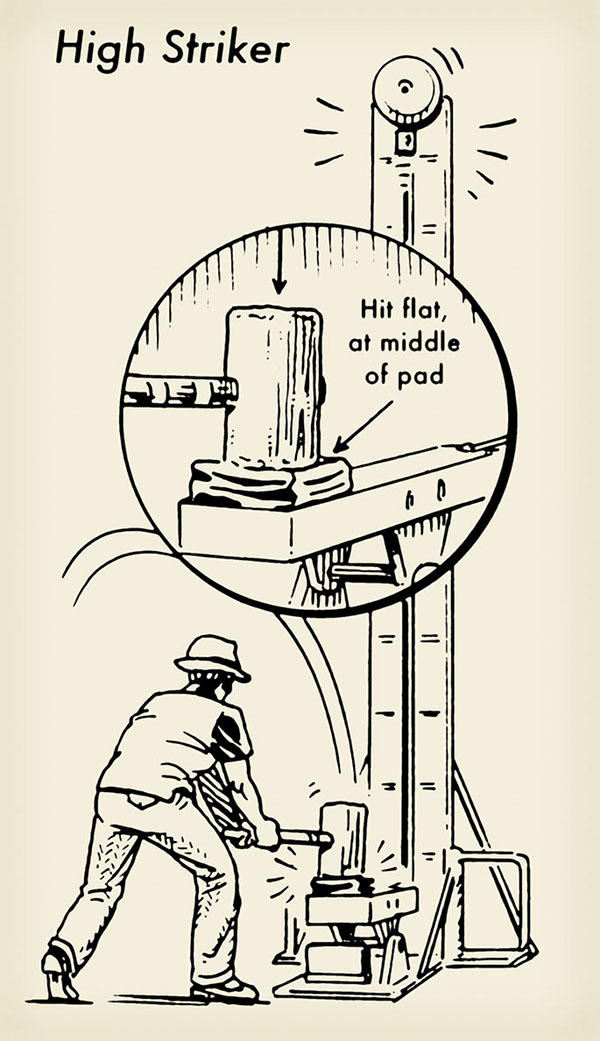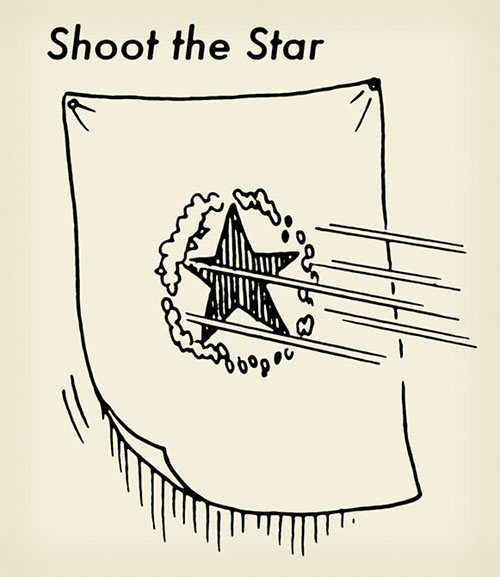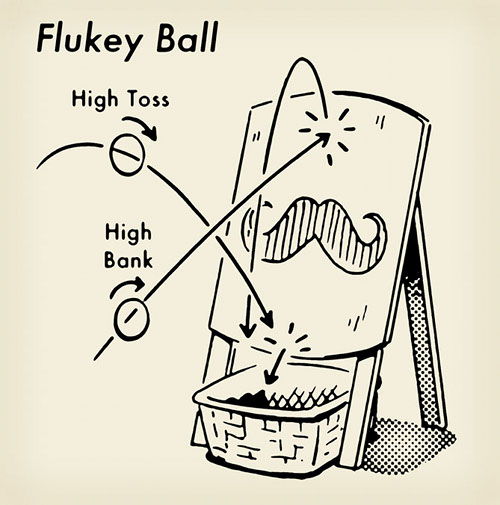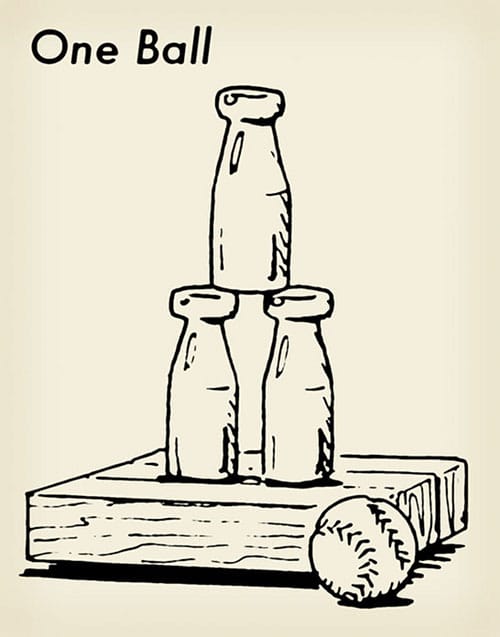Beat the Carnies: The Secrets to Winning 5 Popular State Fair Games
It’s state fair time once again all over the country. And that means Ferris wheels, giant turkey legs, a visit from the world’s smallest horse, and, of course, the chance to try your hand at winning the carnival games that line the midway.
If you love playing these games at the state fair, but usually find yourself walking away from the booths empty-handed or with a dinky Chinese finger trap as a consolation prize, then this post is for you.
Step right up, gentlemen! Today you’re going to learn the secrets to beating the carnies and winning a giant stuffed animal for your gal.
Assume most games are gaffed. Gaffed is carnie speak for rigged. Gaffs in midway games lie on a spectrum that ranges from “nudge, nudge, wink, wink” to downright criminal. Most gaffs don’t make the games impossible to win. They just make you work harder. For example, it’s common knowledge that the basketball rims at carnival free throw shooting games are usually smaller than regulation-size and bent into an oblong shape to appear larger in the front. Moreover, the baskets are often hung higher than regulation basketball goals. You can still make a basket, it just take a bit more skill and finesse.
Bottom line, if a game looks really easy to win, assume that something’s been gaffed to make it harder.
Watch before you put down your money. One way to guard yourself from gaffed games is to watch other suckers, I mean customers, play. Check to see if the carnie uses different balls when he’s demonstrating the game from the ones he gives the customers. Observe what works for successful players.
Ask questions. Don’t assume you understand how the game works or what the rules are. Milk Can at the Vermont State Fair might have different rules than Milk Can at the Tulsa State Fair. Before you lay your money down, ask questions so you know exactly what you have to do to win.
Use the same equipment and stand where the carnie stood while playing. Carnies often demonstrate games to customers to show them how easy it is to win. When you step up to the counter, and before you lay your money down, ask the carnie if you can use the same ball he did and stand in the same spot he was standing in when he successfully completed the game. If the carnie hems and haws, it’s probably a sign that the game is gaffed and can only be won using a certain ball or if you’re standing in a certain spot. Take your money elsewhere.
Have fun! Don’t forget to have fun. Some people take these games way too seriously and scream bloody murder if they lose. If you lose, no need to make a federal case out of it. Most of the prizes aren’t even worth the $2 you paid to play the game. When I play state fair midway games, I like to think I’m paying $2 for a chance to test my skill at a particular game and to match wits with a carnie. It’s entertainment! If I lose, at least I had some fun doing it. On to the deep fried Snickers bar!

Milk Can is a classic state fair game that has been part of midways for over a century. The object of the game is simple: Toss a softball into a 10-gallon metal milk can from a line about four to six feet from the can. Sounds easy, right? Well, here’s the catch: these aren’t your ordinary milk cans. For carnivals, a concave piece of steel is welded to the rim of the can, making the hole just one-sixteenth of an inch larger than the softball. That’s a tight squeeze. Despite the small margin of error, Milk Can is actually one of the easier games to win (if you use the right technique). And it also usually offers some of the largest prizes on the midway.
The secret to winning Milk Can is to give the ball a bit of backspin and hit the back of the can’s rim. The backspin will decrease the ball’s momentum, and instead of bouncing off the can, it will slide into the hole. Easier said than done, of course!
Aim for the back of the rim. Remember, we’re trying to deflect the ball in, not sink the ball straight through the hole.
Toss the ball underhanded, but grip the ball on top. This will allow you to give the ball the needed backspin.
Give the ball some backspin as you release it. As you release the ball, give a little flick of the wrist so the ball starts spinning backwards in the air.
Throw the ball softly and with little arc. This point is debatable. Some people suggest that you give the ball a high arc so that it lands directly in the hole. While you could certainly go this route, there are two reasons you shouldn’t. First, the high arc might not be possible. Some carnies take this approach out of the equation by hanging big stuffed animal prizes right over the milk can, thus blocking a lofty throw. Second, the hole is too freaking small! You’d pretty much have to hit the hole dead-on to win. Remember, the best way to win Milk Can is to bank the ball off the back rim with some backspin. A soft, low-arc toss, with plenty of backspin will ensure that the ball sinks into the hole.

Ah, the Rope Ladder. My childhood nemesis. I don’t know how much money I’ve sunk into this game trying to reach the top, only to find myself spinning upside-down and being tossed onto a mattress. Defeat never tasted so bitter. Only the taste of a corn dog could wash it out of my mouth.
Rope Ladder is an addicting carnival game because it looks so simple to win. The object is to climb up an angled rope ladder with nine rungs and ring the bell at the top. The only problem is that both ends of the ladder are suspended over pivoting pulleys. One false move by a climber, and he’ll find himself spun upside-down and thrown off the ladder.
My 10-year-old self always thought the game was rigged, but Rope Ladder is actually very winnable. The secret is maintaining perfect balance the entire way up the ladder. Here’s how:
Make your center of gravity as wide as possible. Most people try to climb the rope ladder like it was any regular ladder–with feet and hands near the center of the rungs. Taking that approach will result in a guaranteed spin to the mattress. Instead of placing your hands on the rungs, place them on the rope. Next, place your feet as wide as possible on the rung, ideally where the rung and the rope meet.
Counterbalance every movement on the right side of your body, with a movement on the left. This is the tricky part. In order to maintain balance as you scale up the ladder, you need to counterbalance your movements. For example, when you lift your right arm to the next rung, you must simultaneously lift and move your left foot the same distance. Think of the way your dog walks–when he moves his right front leg forward, he moves his left rear leg, too, and vice versa. Do the same thing.
Lean forward. Best to keep your weight forward. Any shift back and you’ll be looking up at the sky.
Watch your knees and feet. Your knees and feet are prone to getting caught in the rope or on a rung while climbing up. To avoid that, keep your knees and toes pointed to the outside of the rope.

For over a century, men at county and state fairs across America have tested their he-man strength with High Striker. Sometimes they compete for a stuffed doll for their gal, and sometimes the prize is the manly pride of beating their buddies.
If you’ve been to a fair or carnival, you’ve seen this game. A carnie stands next to a tower, goading men to step on up and show off their manly strength. Contestants are handed a heavy mallet and instructed to hit a pad that will launch a small puck up a track (usually a metal rod) along the tower. The man who rings the bell at the top wins the prize.
Many men think the key to winning this game is strength. Big buff football dudes will take the mallet in their paws and swing it as hard as they can, only to see the puck get up to the “Puny Weakling” level on the Strength-O-Meter. Dejected, they hand the mallet to their shrimp of a friend, only to see him ring the bell with ease, as seen in this great clip from Pride of the Yankees:
The most important factor is swing accuracy. While strength is necessary, you have to hit the pad directly in the center if you want to ring that bell.
Swing the mallet just as you would when splitting wood. There are two schools of thought on proper swing technique. The first and most prevalent is to swing the mallet just like you’re splitting wood. Start with your stronger hand towards the head of the mallet and your weaker hand as close to the end of the handle as possible. Bring the mallet up and over your head, and as you swing down towards the pad, your strong hand will slide down toward the end of the handle to meet your weaker hand. This technique gives you a bit more control and balance.
The other school of thought is to hold the handle as near to the end as possible with both hands and just bring the mallet head directly over your head and swing down. Sort of like Mario in Donkey Kong. Give a slight flick of the wrists–like Lou Gehrig does in the clip–right before you hit the pad. This technique gives you more power, but you lose some control and, consequently, accuracy.
Use whichever of the two techniques works for you.
Aim for the center of the pad. Remember, the center of the pad is the sweet spot.
Make sure the face of the mallet hits the pad squarely. If the mallet’s face is tilted when you hit the pad, you lose some of the oomph in your swing. You want the mallet face to hit the pad flatly and squarely.

What man can pass up a chance to show off his marksmanship skills with Shoot the Star? You’re given a BB gun and 100 BBs. The object of the game is to shoot out every bit of the red star off the target with just 100 BBs. It’s a difficult task, but doable with the right know-how.
Check the size of the star. Back in the 1980s, the FBI actually ran a study on the chances a player has of winning Shoot the Star. They determined that the game can be won if the diameter of the star is less than 1 and 1/2 inches. Your chances increase as the star gets smaller. Your best odds are when the star is an inch wide or smaller in diameter.
Check the type of paper. The type of paper the target is printed on is another factor in shooting out the star. If the target is printed on high fiber paper or linen, shooting out the star will be more difficult.
Self-zero the gun. The BB guns you’ll be using have probably seen years of wear and use, so they likely have flaws and don’t shoot straight. Some people think that carnies purposely bend the rifle barrels a bit so they don’t shoot true and straight. Either way, you’ll likely need to make adjustments in how you aim, so you can hit your intended target. You can do this quickly through self-zeroing.
Aim right above the top point of the star and quickly fire 3-4 BBs. Check where the BBs actually hit. They probably didn’t hit where you aimed. To make up for that, you’ll need to adjust where you aim the gun so the BBs hit where you want them to hit.
If the BBs hit a bit high and right of where you aimed, you’ll know you’ll need to aim down and to the left to hit your intended target. It might take a few shots to get used to this.
Shoot a circle around the star. This is the big secret to winning this game. When most people read the instructions–”All Red Star Must Be Shot from Card to Win a Prize”–the first thing they do is take aim at the center of the star and try to obliterate all the red, piece by piece, with their 100 BBs. This strategy is almost guaranteed to fail. There will almost always be just a wee bit of red left–one hanging red “chad” and you’re sunk.
Instead of shooting out the red piece by piece, shoot a circle pattern around the star. You’re basically cutting the red star out in a circle with your pellets. Difficult? Definitely. You’ll need around a 90% accuracy rate to accomplish the task. But it’s not impossible. Just take it slow and use the tips above.

In Flukey Ball, contestants must bank a wiffle ball off a slanted board and into the basket below. Sounds easy enough, but don’t be deceived. This game is tricky. But with the right technique, you can dominate it and win oversized combs by the fistful.
First, understand that the size of the board, the board’s angle, the size of the basket, the weight of the ball, and your distance from the target will vary from fair to fair. You’ll need to adapt these tips to your game’s unique set-up and rules.
Ask if you can lean. The closer you can get to the board, the easier it is to get the ball into the basket. If you can lean over the railing, lean over as far as possible to increase your chances of sinking the shot.
Make sure you use the same ball as the carnie. Some unscrupulous carnies will demonstrate how easy it is to win by using a heavier wiffle ball. Heavier balls are more likely to land in the basket after banking off the board. Watch to see which ball the carnie uses. If you notice that he gives you something different than what he used, he probably gave you the lighter, regulation-weight wiffle ball. Ask if you can use his.
Just graze the board. There are two different techniques to win Flukey Ball. What they both have in common is the need to toss the ball as lightly as possible and to just graze the board with it.
The first technique is called the High Toss method. Toss the ball as high as you can, but aim it so that on the downward arc it just grazes the middle of the board.
The second technique is the High Bank method. Instead of hitting the board on the way down, you graze the top of the board as the ball is going up so that it arcs back down into the basket.
Which method you use is a matter of preference.
Give it some front spin. Whether you use the High Toss or High Bank methods, to ensure your ball goes in, add a bit of frontspin as you release it.
While most of the complete scam games at carnivals and state fairs have been outlawed in many states, there are a few games still around that you should avoid, as they are often gaffed in a way that makes it impossible to win.

One Ball is a popular state fair game that has bilked customers for decades.
Three old-fashioned looking milk bottles are stacked in a pyramid on top of a box. You’re given one throw with a softball to knock all three milk bottles off the box. It looks like if you hit the ball right in the middle of the triangular zone where the three bottles meet, the stack will come tumbling down. You give your hardest throw and make a direct hit, only to find a single bottle remaining on the box. Gaaaaa!!!! You club yourself over the head with a giant turkey leg in frustration.
Here’s how One Ball can be subtly gaffed so that it’s impossible for you to win.
The carnie will make one of the bottles heavier than the other two, but still light enough that it can be knocked off the table with a direct hit. When the carnie sets up the bottles, he’ll put the heavy bottle on the bottom row and slightly to the rear. When you throw your ball, it will hit the lighter bottles first, but won’t have enough energy to knock the heavy bottle off.
If people get suspicious, the carnie will show that it’s indeed possible to win with a quick demonstration. However, when he sets up the pyramid for himself, he’ll put the heavy bottle ontop of the pyramid which makes it easy to knock all three bottles off if you hit the ball right in the middle of the pyramid.
The gaff is so hard to detect that it’s just not worth paying money to play this game.

Here’s the typical setup for Swinger: A wooden pin sits on a table. Above it hangs a ball suspended from a rope. The object of the game is to swing the ball past the pin and knock it over as it returns towards you. Easy, right?
Nope.
If the pin is sitting directly under the hanging ball, it’s impossible to win. Here’s why.
In order to swing the ball past the pin first, you’ll have to swing the ball to the side of the pin in an arc. Basic physics says your ball will return in an arc the same distance from the pin on the return swing, meaning the ball will miss the pin completely on its way back.
If the pin is placed one inch to the right or left of the point where the ball hangs, then you have a chance to knock it over on the return swing. Carnies will often let you practice with this set-up so you’re fooled into thinking you can win. But when the throw actually counts, they’ll shift the pin directly underneath the point where the ball hangs. The shift is so small that it can be hard to detect.
Just avoid this game.

No comments:
Post a Comment